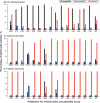Highly Drug-Resistant Salmonella enterica Serovar Indiana Clinical Isolates Recovered from Broilers and Poultry Workers with Diarrhea in China
- PMID: 26824960
- PMCID: PMC4776016
- DOI: 10.1128/AAC.03009-15
Highly Drug-Resistant Salmonella enterica Serovar Indiana Clinical Isolates Recovered from Broilers and Poultry Workers with Diarrhea in China
Abstract
Highly drug-resistant Salmonella enterica serovar Indiana became the most common serovar in broilers with diarrhea in China over the course of this study (15% in 2010 to 70% in 2014). While most S. Indiana isolates (87%, 384/440) were resistant to 13 to 16 of the 16 antibiotics tested, 89% of non-S. Indiana isolates (528/595) were resistant to 0 to 6 antibiotics. Class 1 integrons and IncHI2-type plasmids were detected in all S. Indiana isolates, but only in 39% and 1% of non-S. Indiana isolates.
Copyright © 2016, American Society for Microbiology. All Rights Reserved.
Figures



Similar articles
-
Unique class 1 integron and multiple resistance genes co-located on IncHI2 plasmid is associated with the emerging multidrug resistance of Salmonella Indiana isolated from chicken in China.Foodborne Pathog Dis. 2013 Jul;10(7):581-8. doi: 10.1089/fpd.2012.1455. Epub 2013 May 14. Foodborne Pathog Dis. 2013. PMID: 23672474
-
Characterization of multidrug-resistant Salmonella enterica serovars Indiana and Enteritidis from chickens in Eastern China.PLoS One. 2014 May 2;9(5):e96050. doi: 10.1371/journal.pone.0096050. eCollection 2014. PLoS One. 2014. PMID: 24788434 Free PMC article.
-
Emergence of Salmonella enterica serovar Indiana and California isolates with concurrent resistance to cefotaxime, amikacin and ciprofloxacin from chickens in China.Int J Food Microbiol. 2017 Dec 4;262:23-30. doi: 10.1016/j.ijfoodmicro.2017.09.012. Epub 2017 Sep 23. Int J Food Microbiol. 2017. PMID: 28957726
-
Prevalence and Antimicrobial Resistance of Salmonella enterica Serovar Indiana in China (1984-2016).Zoonoses Public Health. 2017 Jun;64(4):239-251. doi: 10.1111/zph.12328. Epub 2016 Dec 23. Zoonoses Public Health. 2017. PMID: 28009105 Review.
-
[Advances on antimicrobial resistance research of Salmonella enterica Serovar Indiana].Zhonghua Yu Fang Yi Xue Za Zhi. 2018 Nov 6;52(11):1195-1199. doi: 10.3760/cma.j.issn.0253-9624.2018.11.021. Zhonghua Yu Fang Yi Xue Za Zhi. 2018. PMID: 30419710 Review. Chinese.
Cited by
-
The Impact of an Antibiotic Stewardship Program on the Consumption of Specific Antimicrobials and Their Cost Burden: A Hospital-wide Intervention.Risk Manag Healthc Policy. 2020 Sep 23;13:1701-1709. doi: 10.2147/RMHP.S265407. eCollection 2020. Risk Manag Healthc Policy. 2020. PMID: 33061704 Free PMC article.
-
Analysis of Osmotic Tolerance, Physiological Characteristics, and Gene Expression of Salmonella enterica subsp. enterica Serotype Derby.ACS Omega. 2023 Sep 21;8(39):36088-36099. doi: 10.1021/acsomega.3c04257. eCollection 2023 Oct 3. ACS Omega. 2023. PMID: 37810736 Free PMC article.
-
Iron oxide nanozyme suppresses intracellular Salmonella Enteritidis growth and alleviates infection in vivo.Theranostics. 2018 Nov 29;8(22):6149-6162. doi: 10.7150/thno.29303. eCollection 2018. Theranostics. 2018. PMID: 30613289 Free PMC article.
-
Serotype, antimicrobial susceptibility and genotype profiles of Salmonella isolated from duck farms and a slaughterhouse in Shandong province, China.BMC Microbiol. 2019 Sep 2;19(1):202. doi: 10.1186/s12866-019-1570-z. BMC Microbiol. 2019. PMID: 31477003 Free PMC article.
-
The Prevalence and Epidemiology of Salmonella in Retail Raw Poultry Meat in China: A Systematic Review and Meta-Analysis.Foods. 2021 Nov 10;10(11):2757. doi: 10.3390/foods10112757. Foods. 2021. PMID: 34829037 Free PMC article. Review.
References
-
- Beckers HJ, Daniels-Bosman MSM, Ament A, Daenen J, Hanekamp AWJ, Knipschild P, Schuurmann AHH, Bijkerk H. 1985. Two outbreaks of salmonellosis caused by Salmonella Indiana: a survey of the European summit outbreak and its consequences. Int J Food Microbiol 2:185–195. doi:10.1016/0168-1605(85)90038-8. - DOI
Publication types
MeSH terms
Substances
LinkOut - more resources
Full Text Sources
Other Literature Sources
Medical

